
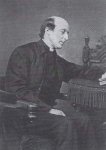 In
August 1856 the Revd
Charles Fuge Lowder,
inspired by reading the life and writings of St Vincent de Paul,
accepted the Rector's invitation to lead the
mission at
St George-in-the-East at the centre of the London Docks. Interestingly
in the light of modern-day church planting, they corresponded at length
over how much independence the Mission might have, Bryan King insisting
courteously but firmly that church law required him, as Rector, to
retain ultimate responsibility, with the clergy licensed as his
assistant curates - a stance he was to maintain in all that followed.
Lowder also discussed the situation with his parents, with whom he was
very close.
In
August 1856 the Revd
Charles Fuge Lowder,
inspired by reading the life and writings of St Vincent de Paul,
accepted the Rector's invitation to lead the
mission at
St George-in-the-East at the centre of the London Docks. Interestingly
in the light of modern-day church planting, they corresponded at length
over how much independence the Mission might have, Bryan King insisting
courteously but firmly that church law required him, as Rector, to
retain ultimate responsibility, with the clergy licensed as his
assistant curates - a stance he was to maintain in all that followed.
Lowder also discussed the situation with his parents, with whom he was
very close.¶ the Society of the Holy Cross (SSC, from its Latin title), which Lowder and five others formed in 1855, dedicating themselves to lives of self-disciplined service to the poor and the extension of the Catholic faith. Membership required obedience to a rule of life: Lowder adopted the white rule, the strictest, requiring celibacy.
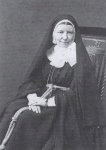 ¶
the Community
of the Holy Cross, newly-founded by
Elizabeth Neale (sister of John
Mason Neale)
who brought her
sisters to work at the mission in the same year. [In 2011 the Community
moved from Rempstone Hall in Leicestershire, a large listed mansion
built in 1792, to more modest purpose-built accommodation nearby in
Costock - their website is here.]
¶
the Community
of the Holy Cross, newly-founded by
Elizabeth Neale (sister of John
Mason Neale)
who brought her
sisters to work at the mission in the same year. [In 2011 the Community
moved from Rempstone Hall in Leicestershire, a large listed mansion
built in 1792, to more modest purpose-built accommodation nearby in
Costock - their website is here.]
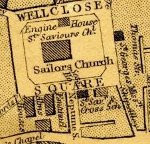 The
presence of the sisters, alongside one or more assistant clergy and
layworkers, enabled the Mission to provide a wide range of activities
and facilities alongside a very full programme
of services: schools, a 'penitentiary' or refuge for
prostitutes (started in
Calvert Street in 1858, moving to Sutton the next year
and to Hendon in 1860), St Stephen's Home (an industrial
school
for boys, which also moved from Calvert Street to Hendon), a hostel for
homeless girls, night classes and parish clubs, an insurance scheme
for dockers, coal for the poor and general poor relief. Over
the
next
ten years, a club for working men and a boys' institute and club,
with a drum-and-fife band, were established at Wellclose Square - this 1868 map [left] shows their location. Staff
and activities moved between the various premises, but eventually the
sisters settled in the Calvert Street house and the clergy at 44
Wellclose Square. Accounts from 1860
and 1863
give more
detail of the work.
The
presence of the sisters, alongside one or more assistant clergy and
layworkers, enabled the Mission to provide a wide range of activities
and facilities alongside a very full programme
of services: schools, a 'penitentiary' or refuge for
prostitutes (started in
Calvert Street in 1858, moving to Sutton the next year
and to Hendon in 1860), St Stephen's Home (an industrial
school
for boys, which also moved from Calvert Street to Hendon), a hostel for
homeless girls, night classes and parish clubs, an insurance scheme
for dockers, coal for the poor and general poor relief. Over
the
next
ten years, a club for working men and a boys' institute and club,
with a drum-and-fife band, were established at Wellclose Square - this 1868 map [left] shows their location. Staff
and activities moved between the various premises, but eventually the
sisters settled in the Calvert Street house and the clergy at 44
Wellclose Square. Accounts from 1860
and 1863
give more
detail of the work.
The
mission pioneered high church practices (Lowder was possibly the
first Anglican priest in London to wear eucharistic vestments), and
attracted protests and attacks (on one occasion a dead cat was flung at
him) – though these were mainly focused on the parish church
itself: see the page on the Ritualism Riots.
Lowder always sought to be loyal to the Church of England, and was
distressed by the conversion of friends and colleagues to the Roman
Catholic church. He was deeply affected when three of his curates
(Wyndham, Shepcote and Akers) were received into the Roman Catholic
Church on the same day - Akers having assured the congregation in his
sermon the previous Sunday that the Church of England provided 'safety'
and liberty! Lowder constantly pushed himself to the limit, and needed
regular continental trips to recover from the stress of it all.
He wrote Ten Years in St. George's Mission (1867) and Twenty-one Years in St. George's Mission (1877) which includes this passage:
| Wellclose
Square, in which our Mission House was situated, is a large open
square forming the meeting point of the three parishes of St
George's, St Mary's Whitechapel, and St John's Wapping... The poverty
of the place was very great.... In the midst of scenes of sin and
misery the children were brought up, the school of too many the
streets, abounding in temptation, echoing with profane and disgusting
language, and forming a very atmosphere of vice.... The parish had
very few redeeming features; scarcely any residents of education and
respectability to foster a better spirit.... The church had little
influence; what wonder that when the rector attempted to throw a
little life into the services and teach the doctrines of the Church
faithfully, that he should meet with opposition.... The mischief
which afterwards burst forth in the St George's riots had been
already smouldering.... It was in the presence of such a population,
and in the face of such difficulties without and trials within, that
the St George's Mission was now making ground in its campaign against
sin. [Life in the clergy house and church was conducted on semi-monastic principles....] The first bell for rising was rung at 6.30; we said Prime in the Oratory at 7; Matins was said at 7.30, followed by the celebration of the Holy Eucharist.* After breakfast, followed by Terce, the clergy and teachers went to their respective work -- some in school, some in the study or district. Sext was said at 12.45, immediately before dinner, when the household were again assembled.... After dinner, rest, letters, visiting or school work, as the case might be, and then tea at 5.30. After tea, choir practice, classes, reading or visiting again until Evensong at 8.00. After service the clergy were often engaged in classes, hearing confessions, or attending to special cases. Supper at 9.15, followed by Compline, when those who had finished their work retired to their rooms. |
|
Lowder,
who died in 1880, is commemorated in the Church of England calendar on
9 September. Here and here are two unashamedly partisan portraits of him; and see Maria Trench Charles Lowder: A Biography (1882). William Walsham How, whose story as Bishop of Bedford is told here, was a great admirer of Lowder, and wrote this sonnet [right] about him; see also the following one in this series, about Harry Jones, Rector of St George-in-the-East. |
Like some tall rock that cleaves the headlong might
Of turgid waves in full flood onward borne, So stood he, fronting all the rage and scorn, And calmly waiting the unequal fight. He fashioned his ideal — stately rite. High ceremonial, shadowing mystic lore; The Cross on high before the world he bore, Yet lived to serve the lowliest day and night. He could not take offence men held him cold; Yet was his heart not cold, but strongly just, And full of Christ-like love for young and old. They knew at last, and tardy homage gave; They crowned him with a people's crown of trust; And strong men sobbed in thousands at his grave. |
Lowder
was joined by the Revd Alexander Heriot Mackonochie (1858-62) prior to his taking charge of St Alban
Holborn. Of his
time at the Mission, the Revd T. I. Ball later wrote:
Among the colourful sequence of clergy who worked with Lowder and Mackonochie at the Mission (licensed as curates to the parish church) were
 Hubert
de Burgh (1856-58):
from
a wealthy Irish family, was born in 1830 and baptized in a free church
in Dublin, and studied at Trinity College there; he was a curate at
Lawshall in Suffolk, and in 1856 was briefly a chaplain
attached to the Turkish
contingent in the Crimean War. He was received into the Roman Catholic
Church in 1858 and was (re-)ordained; by 1862 he was at St Mary, Grace
Dieu Manor, Ashby-de-la-Zouch (where the chapel and priest's house were
built by Ambrose de Lisle in 1842). In 1869 he went to the USA (banking
with the New York Emigrants Bank), and served at Belleville, Essex
County, New Jersey, where in 1876 he founded Our Lady of Grace church
Nutley, for Irish and Italian quarrymen. In 1883 he moved to St Mary
Plainfield, in Union County New Jersey, but by 1886 had returned to
England, to St Edward New Hall in Burton-on-Trent (a large gothic
chapel erected in the village by the Countess of Loudoun). In 1900 he
was in Ashbourne, but died the following year in Blackheath, aged 70.
Hubert
de Burgh (1856-58):
from
a wealthy Irish family, was born in 1830 and baptized in a free church
in Dublin, and studied at Trinity College there; he was a curate at
Lawshall in Suffolk, and in 1856 was briefly a chaplain
attached to the Turkish
contingent in the Crimean War. He was received into the Roman Catholic
Church in 1858 and was (re-)ordained; by 1862 he was at St Mary, Grace
Dieu Manor, Ashby-de-la-Zouch (where the chapel and priest's house were
built by Ambrose de Lisle in 1842). In 1869 he went to the USA (banking
with the New York Emigrants Bank), and served at Belleville, Essex
County, New Jersey, where in 1876 he founded Our Lady of Grace church
Nutley, for Irish and Italian quarrymen. In 1883 he moved to St Mary
Plainfield, in Union County New Jersey, but by 1886 had returned to
England, to St Edward New Hall in Burton-on-Trent (a large gothic
chapel erected in the village by the Countess of Loudoun). In 1900 he
was in Ashbourne, but died the following year in Blackheath, aged 70.| PRIVATE GRAMMAR SCHOOL for Gentlemen, Waterfield-terrace BLACKHEATH, conducted by the Rev. J.A. TEMPLE, M.A. Terms for Boarders. Fifty guineas per annum, The course of Instruction affords a thorough preparation for the Public Schools. Younger pupils are under the especial charge of Mrs Temple. |
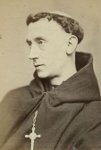

 Joseph
Leycester Lyne (nine months in
1861) – the eccentric 'Father Ignatius' was a self-styled
Benedictine monk. Ordained deacon on condition that he did not
proceed to priesthood, and abstained from preaching for three years,
he was given a monastic habit by Dr Pusey, but his father objected to
him wearing it. So too did Lowder – so he left. He eventually
established a community at Llanthony, and in later life was ordained
priest by an Old Catholic episcopus
vagans. You
can read more about him here
and here,
in A.Calder-Marshall
The Enthusiast: An Enquiry into the Life, Beliefs and Character of the
Rev. Joseph Leycester Lyne alias Father Ignatius OSB (1962), and there is a chapter about him in Bernard Palmer Reverend Rebels (DLT 1993). The cartoon, right, is from Vanity
Fair (1887), plus images from 1864 and an 1870s carte-de-visite by Samuel Alexander Walker, from the National Portrait Gallery.
Joseph
Leycester Lyne (nine months in
1861) – the eccentric 'Father Ignatius' was a self-styled
Benedictine monk. Ordained deacon on condition that he did not
proceed to priesthood, and abstained from preaching for three years,
he was given a monastic habit by Dr Pusey, but his father objected to
him wearing it. So too did Lowder – so he left. He eventually
established a community at Llanthony, and in later life was ordained
priest by an Old Catholic episcopus
vagans. You
can read more about him here
and here,
in A.Calder-Marshall
The Enthusiast: An Enquiry into the Life, Beliefs and Character of the
Rev. Joseph Leycester Lyne alias Father Ignatius OSB (1962), and there is a chapter about him in Bernard Palmer Reverend Rebels (DLT 1993). The cartoon, right, is from Vanity
Fair (1887), plus images from 1864 and an 1870s carte-de-visite by Samuel Alexander Walker, from the National Portrait Gallery.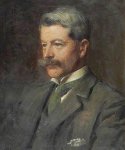
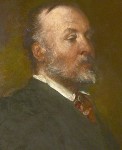 He was related by marriage* to Sir Andrew Clark [left],
a notable President of the Royal College of Physicians and other
medical bodies, who worked at the London Hospital for twenty years
(endowing a scholarship there) and treated the rich and famous,
including royalty, from his consulting rooms in Cavendish Square; here and here
are two contrasting accounts of his life. The Clarks stayed with Kane's
unmarried sister at Gosport, and Kane was one of his executors when he
died in 1893, leaving over £200,000 (including £80,000 to endow his
baronetcy). The following year the Christian Evidence Society published
his address The Physician's Testimony for Christ.
He was related by marriage* to Sir Andrew Clark [left],
a notable President of the Royal College of Physicians and other
medical bodies, who worked at the London Hospital for twenty years
(endowing a scholarship there) and treated the rich and famous,
including royalty, from his consulting rooms in Cavendish Square; here and here
are two contrasting accounts of his life. The Clarks stayed with Kane's
unmarried sister at Gosport, and Kane was one of his executors when he
died in 1893, leaving over £200,000 (including £80,000 to endow his
baronetcy). The following year the Christian Evidence Society published
his address The Physician's Testimony for Christ.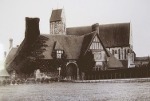 Laughton Alison (1864-65),
from Park Hall, Charnock Richard in Lancashire (baptized at Euxton) via Trinity College Cambridge, was ordained deacon by
the Bishop of Jamaica and
priest by the Bishop of Exeter, serving his first curacy in Paignton.
For a number of years he was the 'Foreign Secretary' of SSC, maintaing
the list of those serving overseas. From 1867 to his death in 1892
(aged 53) he was Chaplain of the Society
of St Margaret
in East Grinstead [right], succeeding their founder John Mason Neale. Initially
distrusted for his extreme views, he became much-loved, and the sisters
dedicated the third edition of Neale's Sermons on the
Blessed Sacrament to him. He was a keen traveller, keeping
journals (now at Lambeth Palace Library) of trips around Europe in 1865, 1871 and 1887.
Laughton Alison (1864-65),
from Park Hall, Charnock Richard in Lancashire (baptized at Euxton) via Trinity College Cambridge, was ordained deacon by
the Bishop of Jamaica and
priest by the Bishop of Exeter, serving his first curacy in Paignton.
For a number of years he was the 'Foreign Secretary' of SSC, maintaing
the list of those serving overseas. From 1867 to his death in 1892
(aged 53) he was Chaplain of the Society
of St Margaret
in East Grinstead [right], succeeding their founder John Mason Neale. Initially
distrusted for his extreme views, he became much-loved, and the sisters
dedicated the third edition of Neale's Sermons on the
Blessed Sacrament to him. He was a keen traveller, keeping
journals (now at Lambeth Palace Library) of trips around Europe in 1865, 1871 and 1887. 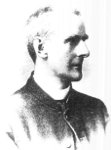 George
Akers (1864-68)
- his family were
early settlers in St Kitts and active in the abolition of slavery; his
uncle Aretas Akers-Douglas later became Home Secretary and 1st
Viscount Chilston. He was a student at Oriel College Oxford; before he came to the Mission he was F.G.
Lee's curate at St Mary's Aberdeen, where 'advanced' services
had been
introduced (see here for
details of a fellow-curate Thomas Dove's failure to become its
incumbent). While at the Mission, he wrote a pamphlet Oxford University Election, which is the Church candidate, Mr Hardy or Mr Gladstone? (Masters 1865) - see here for more detail on this intriguing issue, and compare these
comments of Rector J.L. Ross to his old friend Gladstone four years
later when Gladstone was mooted as a candidate for the post of
University Chancellor). He also offered
to provide
£4,000 from his family wealth to build a new church in
Wellclose Square. Instead, he became a
Roman Catholic in 1868; ordained priest in
1870, he served in East London, establishing the mission of The
Immaculate Heart of Mary and St Dominic in Vallance Road in 1873, then was
President of St
Edmund's College Ware (training priests) and a Canon of Westminster,
finally returning to
the East End in 1896 to lead the staff of St Mary & St Michael
in
Commercial Road until his death three years later. A
History of St Mary
& St Michael's Parish, published to
celebrate their 150th anniversary, recalls his time there (p155
ff).
George
Akers (1864-68)
- his family were
early settlers in St Kitts and active in the abolition of slavery; his
uncle Aretas Akers-Douglas later became Home Secretary and 1st
Viscount Chilston. He was a student at Oriel College Oxford; before he came to the Mission he was F.G.
Lee's curate at St Mary's Aberdeen, where 'advanced' services
had been
introduced (see here for
details of a fellow-curate Thomas Dove's failure to become its
incumbent). While at the Mission, he wrote a pamphlet Oxford University Election, which is the Church candidate, Mr Hardy or Mr Gladstone? (Masters 1865) - see here for more detail on this intriguing issue, and compare these
comments of Rector J.L. Ross to his old friend Gladstone four years
later when Gladstone was mooted as a candidate for the post of
University Chancellor). He also offered
to provide
£4,000 from his family wealth to build a new church in
Wellclose Square. Instead, he became a
Roman Catholic in 1868; ordained priest in
1870, he served in East London, establishing the mission of The
Immaculate Heart of Mary and St Dominic in Vallance Road in 1873, then was
President of St
Edmund's College Ware (training priests) and a Canon of Westminster,
finally returning to
the East End in 1896 to lead the staff of St Mary & St Michael
in
Commercial Road until his death three years later. A
History of St Mary
& St Michael's Parish, published to
celebrate their 150th anniversary, recalls his time there (p155
ff).
[ Joseph Redman, who had been a layworker at the Mission, also became a Roman Catholic priest; he was a Doctor of Divinity, and among his publications was an edition of Henri-Marie Bouden The Book of Perpetual Adoration: or, the Love of Jesus in the Most Holy Sacrament (1873). He became involved in soldiers' missions, and with the Rev the Lord Archibald Douglas compiled The Soldier's Companion to the Spiritual Exercises [of St Ignatius] (1878). ]
 North
Green-Armytage (1865-67)
- his father Joseph, from a corn-trading family, had inherited Thick
Hollins Hall in West Yorkshire (now the site of Meltham Golf Club) but
was ordained and later moved south - and published widely. North, born 1838, studied at St John's College
Cambridge (as did his brother Joseph) and served his title at Winlaton,
on Tyneside (then in Durham diocese - he was ordained along with George Cull Bennett, later Vicar of St John the Evangelist-in-the-East), before coming here. Further curacies followed, in Stepney,
Liverpool, Frome-Selwood and Primrose Hill (all parishes of 'advanced'
churchmanship), two European chaplaincies, and a spell as Chaplain of
the House of Mercy, Ditchingham before
he became incumbent of St Aidan's Chapel Boston in Lincolnshire from
1888-1905.
He described himself as a pronounced
High Churchman, but wrote several books and booklets
espousing the 'via media', including Anglo-Catholicism the Safer
Way; or, Four Reasons for not going over to Rome (1890),
Reservation of the Blessed Sacrament for the Sick Lawful
(1895) and Alike yet Unlike; or, the
Roman and Anglican Eucharists or Masses Compared (1907).
North
Green-Armytage (1865-67)
- his father Joseph, from a corn-trading family, had inherited Thick
Hollins Hall in West Yorkshire (now the site of Meltham Golf Club) but
was ordained and later moved south - and published widely. North, born 1838, studied at St John's College
Cambridge (as did his brother Joseph) and served his title at Winlaton,
on Tyneside (then in Durham diocese - he was ordained along with George Cull Bennett, later Vicar of St John the Evangelist-in-the-East), before coming here. Further curacies followed, in Stepney,
Liverpool, Frome-Selwood and Primrose Hill (all parishes of 'advanced'
churchmanship), two European chaplaincies, and a spell as Chaplain of
the House of Mercy, Ditchingham before
he became incumbent of St Aidan's Chapel Boston in Lincolnshire from
1888-1905.
He described himself as a pronounced
High Churchman, but wrote several books and booklets
espousing the 'via media', including Anglo-Catholicism the Safer
Way; or, Four Reasons for not going over to Rome (1890),
Reservation of the Blessed Sacrament for the Sick Lawful
(1895) and Alike yet Unlike; or, the
Roman and Anglican Eucharists or Masses Compared (1907).
 Henry
von-der-Heyde Cowell (1868-9)
- born in Faversham in 1837, as a philosophy student at King's College London in 1860 he had
edited an annotated edition of George Berkeley's 1733
text The Theory of Vision Vindicated & Explained. Ordained
in 1866, after
curacies in Coventry and Stepney, he came to the Mission as London
Diocesan Home Missioner, in charge of St Saviour's, for a year; in 1867 he
married Amelia Elworthy in Wellington, Somerset and they had three
daughters. From 1869 he served the new parish of St
Paul Paddington [the church was closed after bomb damage in 1944]; his household had
two servants and a governess. In 1877 he
spoke at the Church Congress about the certain stigma that
came to attach to clergy who were supportive of the Charity Organisation Society; in 1886 he published a Companion for Confirmation Day. In 1892 by an exchange of livings he went
to Wilmington in Rochester diocese, retiring in
1905; he was also chaplain of Swanley Convalescent Home. He died in 1924.
Henry
von-der-Heyde Cowell (1868-9)
- born in Faversham in 1837, as a philosophy student at King's College London in 1860 he had
edited an annotated edition of George Berkeley's 1733
text The Theory of Vision Vindicated & Explained. Ordained
in 1866, after
curacies in Coventry and Stepney, he came to the Mission as London
Diocesan Home Missioner, in charge of St Saviour's, for a year; in 1867 he
married Amelia Elworthy in Wellington, Somerset and they had three
daughters. From 1869 he served the new parish of St
Paul Paddington [the church was closed after bomb damage in 1944]; his household had
two servants and a governess. In 1877 he
spoke at the Church Congress about the certain stigma that
came to attach to clergy who were supportive of the Charity Organisation Society; in 1886 he published a Companion for Confirmation Day. In 1892 by an exchange of livings he went
to Wilmington in Rochester diocese, retiring in
1905; he was also chaplain of Swanley Convalescent Home. He died in 1924. Edward
Williams -
an Australian, ordained in 1848 by the Bishop of Newcastle, NSW to
serve the missionary district (10,000 square miles, with a population of 2,000) of Liverpool
Plains. Services were held in various local buildings, including the petty session clerk's hut in Wee Waa
which was originally the judicial centre of the region. Three years
later a parsonage and St Paul's Church were built at West
Tamworth*, where he stayed as incumbent until 1861, leaving for England
after an emotional service at which he was reduced to tears several
times, and with a testimonial purse containing £81. After three years
at Holy
Trinity Missionary College in Shrewsbury and a curacy in Birmingham, in
1869 he succeeded
Cowell as Home Missioner, attached both to St Saviour's and to St
Stephen
Spitalfields, and living in
Victoria Park, Hackney. He returned to Australia in 1885, as Rector of
York, in Western Australia, where he died in 1899, aged 76, from injuries received, the result of a carriage accident, whilst discharging his duty. His wife Selina died in Perth in 1909; they had six children.
Edward
Williams -
an Australian, ordained in 1848 by the Bishop of Newcastle, NSW to
serve the missionary district (10,000 square miles, with a population of 2,000) of Liverpool
Plains. Services were held in various local buildings, including the petty session clerk's hut in Wee Waa
which was originally the judicial centre of the region. Three years
later a parsonage and St Paul's Church were built at West
Tamworth*, where he stayed as incumbent until 1861, leaving for England
after an emotional service at which he was reduced to tears several
times, and with a testimonial purse containing £81. After three years
at Holy
Trinity Missionary College in Shrewsbury and a curacy in Birmingham, in
1869 he succeeded
Cowell as Home Missioner, attached both to St Saviour's and to St
Stephen
Spitalfields, and living in
Victoria Park, Hackney. He returned to Australia in 1885, as Rector of
York, in Western Australia, where he died in 1899, aged 76, from injuries received, the result of a carriage accident, whilst discharging his duty. His wife Selina died in Perth in 1909; they had six children.When the Rector Bryan King tried to have a district assigned to this church for the Mission, the minister of St Paul Dock Street, Dan Greatorex (who was a firm Protestant), objected: in a letter of 1863 he described Lowder as Bryan King's co-adjutor and a Romanizer. He stirred up other local clergy, including Thomas Richardson at St Matthew Pell Street, to protest about the subversive spread of 'Puseyism' in Stepney. The Bishop settled the dispute by having a district assigned to St Paul's in 1864. (It had not previously had parish boundaries because it was the 'Church for Seamen of the Port of London'). Since the Mission fell into this district, Greatorex closed it, and bought the building for £2,000, intending to convert it into a school. So all the Mission's activities transferred to Wapping.
By
now the
parish of St Peter London Dock had been created. The church
was consecrated on 30 June 1866, with Lowder as its first Vicar. The
following week the cholera epidemic broke out, and Lowder's
courageous ministry to the afflicted earned him the title of 'the
Father', then simply 'Father' - the first use of this title, it's
claimed, in the Church of England. But
this, and other subsequent events such as the tragic
death of
Mackonochie in a
Scottish blizzard, are not strictly part of our story. The parish has
its own comprehensive website: the former Rector ran an addictive blog about parish life.
There
is one further feature to note. Throughout the 19th century,
and almost to the end of the 20th, Wapping was a distinct and separate
community, physically (it was only accessible via four 'canal'
bridges, and cut off when these were raised), socially and
psychologically, and some say that this divide continues (compounded by
the curious neologisms of 'North / South Wapping'). And yet the Mission
apparently managed to straddle it.
Homepage | About Us | Services & Events
| Church &
Churchyard |
History
Newsletters & Sermons | Contacts,
Links & Registers | Giving | Picture
Gallery |
Site Map